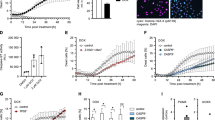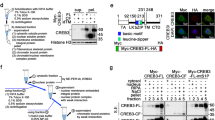Abstract
Ultraviolet (UV)-irradiation has been shown to induce jun N-terminal kinase activity via aggregation-mediated activation of tumor necrosis factor receptor 1 (TNFR1) but the role of TNFR1 in mediating UV-induced apoptosis has not been explored. Using p53-null cells, we demonstrate that UV-stimulated ligand independent activation of TNFR1 plays a major role in mediating the apoptotic effects of UV-irradiation. UV-irradiation and TNFα acted in a synergistic manner to induce apoptosis. UV-irradiation stimulated the aggregation-mediated activation of TNFR1 which was coupled with activation of caspase 8, the most proximal caspase in TNFα signaling pathway. CrmA and the dominant negative versions of FADD, caspase 8 and caspase 10, that block the apoptotic axis of TNFR1 at different levels, also independently inhibited the UV-induced apoptosis. The engagement of the membrane initiated events was specific for UV-irradiation since neither CrmA nor the dominant negative FADD, caspase 8 or caspase 10 blocked the ionizing radiation-induced apoptosis. Cisplatin and melphalan, the UV-mimetic agents known to elicit UV-type DNA damage, also induced apoptosis but differed from UV in that both of the former agents engaged the caspase cascade at a level distal to FADD. Consistent with these findings cisplatin also did not stimulate TNFR1 aggregation. Together these results indicate that DNA damage per se was not sufficient to activate the membrane TNFR1. Based on our results we propose that the plasma membrane initiated events play a predominant role in mediating UV-irradiation-induced apoptosis and that UV-irradiation appears to engage the apoptotic axis of TNFR1 and perhaps those of other membrane death receptors to transduce its apoptotic signals.
This is a preview of subscription content, access via your institution
Access options
Subscribe to this journal
Receive 50 print issues and online access
$259.00 per year
only $5.18 per issue
Buy this article
- Purchase on Springer Link
- Instant access to full article PDF
Prices may be subject to local taxes which are calculated during checkout
Similar content being viewed by others
Author information
Authors and Affiliations
Rights and permissions
About this article
Cite this article
Sheikh, M., Antinore, M., Huang, Y. et al. Ultraviolet-irradiation-induced apoptosis is mediated via ligand independent activation of tumor necrosis factor receptor 1. Oncogene 17, 2555–2563 (1998). https://doi.org/10.1038/sj.onc.1202292
Received:
Revised:
Accepted:
Published:
Issue Date:
DOI: https://doi.org/10.1038/sj.onc.1202292
Keywords
This article is cited by
-
Biophysical evaluation of treating adipose tissue-derived stem cells using non-thermal atmospheric pressure plasma
Scientific Reports (2022)
-
Mcl-1 Functions as Major Epidermal Survival Protein Required for Proper Keratinocyte Differentiation
Journal of Investigative Dermatology (2009)
-
Xaf1 can cooperate with TNFα in the induction of apoptosis, independently of interaction with XIAP
Molecular and Cellular Biochemistry (2006)
-
Differential apoptotic pathways in human keratinocyte HaCaT cells exposed to UVB and UVC
Apoptosis (2005)
-
Molecular Aspects of Ultraviolet Radiation-induced Apoptosis in the Skin
Journal of Cutaneous Medicine and Surgery (2005)



